#advanced language
Explore tagged Tumblr posts
Text
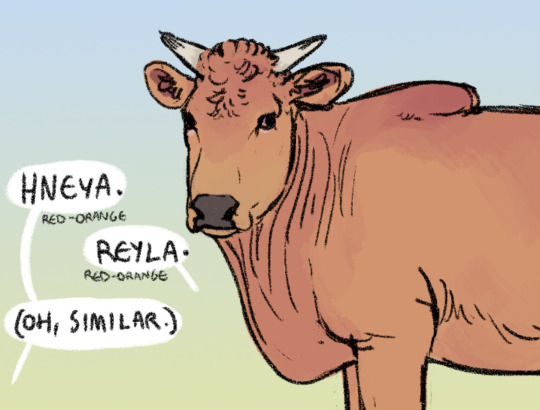

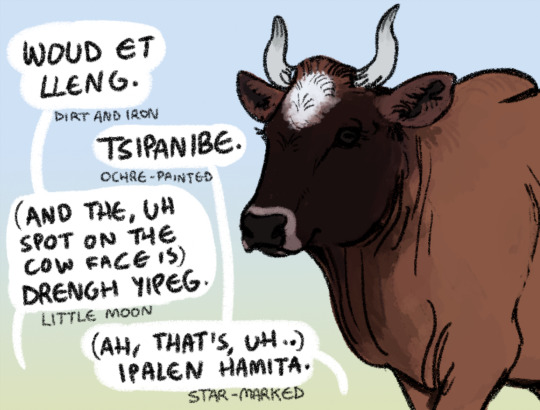
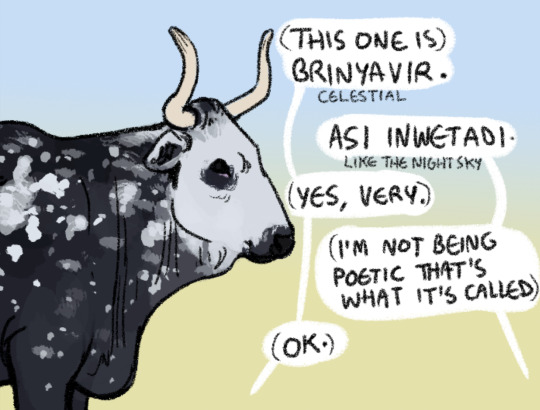
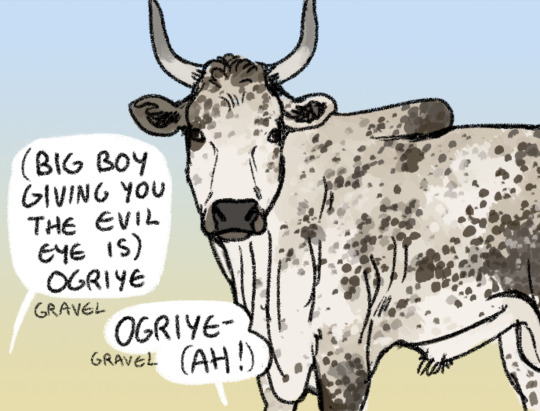
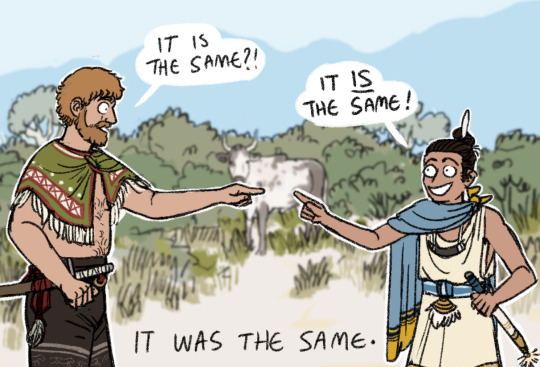
Comparing livestock color-words.
Both the Chenahyeigi and Wardi languages are derived from peoples who have been pastoralists for millennia, and both have an absolute ton of words for livestock coloration.
Both languages have had at least some mutual influence for about a thousand years (to varying extents by dialect, depending on geography/trade connection) so you'll see similar or identical words crop up here and there.
THE WORDS:
Hneya - [hne:ʝɑ] or [hne:jɑ] (whether the ʝ sound is retained in speech and to what extent varies by dialect)
Straightforwardly refers to bright reddish-orange color, but is mostly used for animals rather than other orangeish things. The word Was probably influenced by an older form of the Wardi 'reyla', and absorbed with the introduction of orange colored cattle. It may have been merged with the Chenahyeigi '(h)ne', which is the root of several red color-related terms.
Reyla - [rejlɑ]
This is a Wardi word for most reddish-orange hues in general. When applied to livestock, it refers to solid orange coats without spotting/masks/notable countershading.
Fels akhri - [fels] [ɑ:khɾi]
Translates readily as 'storm cloud' (the 'storm' here specifies thunderstorms). When applied to livestock, it describes fur that is rich dark blue-gray with white guard hairs.
Aganne - [ɑgɑ:ne]
This doesn't actually translate to 'night sea' in a straightforward manner, but as a color word it's poetically associated with dark seas, at night or in storms. When used for livestock, it describes this coloration exclusively.
Woud et lleng - [woʊd] [ɛt] [ɬeŋk]
Woud is the word for rich moist soil specifically, lleng refers to laterite and its association with iron deposits. This phrase is used to describe livestock with dark brown heads and and orange-brown bodies.
Tsipanibe - [t͡sipɑnibe]
This would be more literally translated as 'ochred'. Many Wardi words with the -ibe stem from verbs or nouns modified to indicate that the subject matter has 'received' an action or concept. (Examples of such words are long-established linguistically, you can't just add '-ibe' to any noun or verb). This one takes the root 'tsipan' (ochre) and applies it to the subject matter (cattle coloration).
Livestock with a dark brown or black head and orange-brown body are given this description, the idea being that their bodies look like they've been painted in ochre. This word is extremely rare outside of this context (you would usually just say the full 'ochre-painted' to convey this idea for other things)
Drengh yipeg - [dɾeŋg(h) yɪpɛ:g]
This is pretty straightforwardly 'little moon'. Yipeg comes from the same root as the Wardi 'hippe' for 'small', while drengh refers to the appearance of the moons in the sky (rather than the gods they embody). It's used to describe small round white blaze marks.
Ipalen hamita - [ipɑlɛn (h)ɑmitə]
Straightforwardly 'star marked', used for small round white blaze marks. Wardi actually does have a 'moon marked' (ipalen amit) to describe round white blazes that entirely cover the animal's forehead.
Brinyavir - [bɾi:nʝɑvir] (ʝ is retained for this word in most dialects)
This one is not directly translatable, 'celestial' or 'heavenly' just function closely enough. The word conceptually relates to stars but most specifically describes a layer of sky in which the afterlife rests (brinyavir is part of the phrase I translate as 'celestial fields'). The cattle there are said to have these markings. The stars in the night sky are sometimes playfully described as the spots of these cattle (though not literally, in Chenahyeigi cosmology stars are spirit-inhabited bonfires lit along pathways through the heavens).
As a color word for livestock, brinyavir refers to this rare (I Think nonexistent irl) white-spotted black coloration, due to both resembling the stars and the cattle that are moved among them.
Asi inwetadi - [ɑsi in:wetɑ:di]
This directly means 'like night sky', and is applied to this coat pattern with a similar underlying logic- it looks like a starry night sky. You will often see asi (like/akin to) retained in place or animal names like this, and it is sometimes part of names for people (the name Asinya is derived from a contracted 'like the sun').
Ogriye - Chenahyeigi: [oʊ:gɾije] Wardi: [oʊgɾi:je]
This word is (or was) a way to say 'gravel' or 'gravelly' in both Chenahyeigi and Wardi, and is pronounced very similarly in both (with the only significant difference being emphasis)
In Chenahyeigi it is a loanword from the Wardi language family, most likely received in the exchange of cattle of this coloration. It is retained in general speech as a word for gravel, more specifically the adjective 'gravelly'.
The word is mostly obsolete in contemporary Wardi, speakers do not know it used to mean 'gravel' (though it sounds close enough to assume a connection, the word is 'ogri') and exclusively use it to describe this livestock coloration (one of the more common among Wardi native cattle).
---
Also here's some cow lore.
There's some fairly tremendous diversity in Wardi cattle herds, given they have genetic influence from at least two separate aurochs domestication events (also distant and negligibly minor influence from one instance of bison domestication) and from multiple relatively isolated domestic cattle populations. Present day herds within Wardi provincial territory near-ubiquitously have at least some ancestry from the kulustaig and the Burri tepang cattle.
The ancestors of the Wardi native cow have been in the region for at Least 5,000 years. Burri cattle Possibly could have had tiny, isolated introductions between 2500-3000 years ago (this is extremely unlikely, but maize Was probably introduced by seafaring proto-Burri peoples at this time) or at more recent points since, and the tepang was certainly introduced during Imperial Burri occupation. High quality cattle are also occasionally received in diplomacy with the present-day Different Entity that is the Burri Republic. The kulustaig cattle arrived with proto-Finnic migrants starting 1500 years ago, and is the biggest external genetic influence on Wardi herds. Small populations of Yuroma native cattle arrived with migrants 540 years ago, though these have been wholly absorbed into Wardi herds, with their biggest trace being genes for naturally polled horns. Some Finn cattle were extracted in the recent two decades of Wardi occupation, though not enough to have a noteworthy genetic impact on any herds.
Most of the cattle in this post show predominantly Wardi native cattle + kulustaig ancestry (this takes place in the Ephenni riverlands, where the ancestry of herds tends to be around 2:1). The one with the blaze has a delicate sloping muzzle that suggests Burri tepang ancestry, and also likely has a wild aurochs grandparent (the white ring around the nose is a telltale sign, as it usually vanishes within a few generations of introgression).
Diversity in color and coat pattern is culturally favored for Wardi cattle herds, and selective breeding for aesthetics is usually limited to the purpose of preserving unique coats. The average herd tends to be very colorful, though the one shown here is a bit of an outlier, the universe having mysteriously put in place perfect conditions to compare the words for a variety of coat patterns.
#My marginal comprehension of the IPA has advanced somewhat. For those who don't know : indicates the vowel/consonant beforehand#is long and () means a sound is marginal/optional/not articulated#The 'h's you see at the end of a lot of Chenahyeigi words are usually soft unvoiced exhalations and very subtle#It's part of the accent but not doing it doesn't change the meaning of the word in most cases#The Wardi language has a tendency of dropping H sounds at the beginnings of words over time/in certain dialects#(especially when followed by the [i] vowel. A lot of people pronounce hippegalga as just ippegalga) and in a lot of words#pronunciation of leading H's is essentially optional#One aspect of Wardi formal register is always enunciating these droppable H's
2K notes
·
View notes
Text
Cockslut!reader is always beside Satoru.
He is the one, who is trying to hide from you, from your filthy mouth and a little pussy which doesn’t know how to stop and always eager to feel his cum deep inside.
You don’t know how to keep your hands away from such a piece of art. If he were a lollipop you would suck and lick him like it is the last thing you could do before dying.
It’s really funny, that you still suck him off like you are gonna die in a minute and the last thing you would like to feel is his cum on your tongue with a mushroom heavy tip in your mouth.
“H-honey, please… I am empty, I can’t do-ahh-this an-nymore” Satoru was holding the edge of the table for dear life. He is going to cum for a fourth time in a row, and all you did was deepthroating his thick cock for 30 minutes.
“Baby, stop lying” you pull out his cock with a pop sound, your pupils are too dilated, too thirsty for his cock, signaling Satoru that he is not gonna make it alive. The mix of rosy cheeks and plump lips on your face was too much to handle for a poor man especially when he sees how you grope your tits with a free hand, meanwhile the right one was tightly squeezing his balls, making him cry out loud. “I knooow, that these breeding balls are full of semen and just for me”.
“No-no, i-it hurts” he is literally whimpering and pleading you to stop this torture, but the way he grabs your face with his two palms and starts roughly fuck your face tell you the opposite.
Oohhh, you love when he is turning to an animal with the only ability - fuck your face like a pocket pussy. You are not his love of his life anymore, just a stupid face to fuck and a tummy to fill with his cum.
But, is it really the problem?? You are just a loving wife, who is always ready to fulfill a marital duty.
#gojo satoru#gojo x reader#jjk gojo#jjk x reader#jjk x you#gojo smut#gojo x you#jjk satoru#satoru gojo x reader#trying my best to use advanced vocabulary and still fail#english is not my first language
2K notes
·
View notes
Link
Sanskrit language is both a guardian of ancient wisdom, and the profound healing traditions of Ayurveda. Do you know the enduring significance of Sanskrit, its impact on technology, and its contributions to English language?
Do you know which words in English have been taken from Sanskrit? More on World Sanskrit Day
#ancient wisdom#significance of Sanskrit#impact on technology#ayurveda#alternative medicine#contributions to English language#blog#blogging#bloggers#mathematics#artificial intelligence#structured language#holistic well-being#advanced language#rich vocabulary#grammar#Influence on English#sanskrit diwas#promote Sanskrit#panini#world sanskrit day#International Sanskrit Day#vishva samskrita dinam#ancient texts#ancient language#ancient culture#love for language#indian language#karma
0 notes
Text
It's funny learning both japanese and chinese because in chinese when chinese learners complain about difficult words they are those that have simple strokes, about 3 or less pinyin pronunciations but have 58 different meanings and need specific usages where as in japanese, the difficult kanjis have 40 strokes like they've clawed all the way to earth from hell and have 80 different pronunciation but the meaning is pretty much the same across the words. So when I see chinese learners complain about a difficult word it's "guys, I think we should've left this word to die in classical chinese" but when japanese learners complain about a difficult word my response is either "that's just 8 radicals on top of each other. that's not hard" or "who angered a kami of kunyomi dominion, my god."
#studyblr#langblr#japanese language#chinese language#chinese langblr#japanese studyblr#chinese studyblr#don't mind the korean learners they're crying in the corner#because there's no way to differentiate hanja based advanced words that sound the same#you might think well it can't be bad but they're actively dying from the mountain of vocabs they're supposed to know#because “you can read all of them so you should know all of them” jfc
308 notes
·
View notes
Text
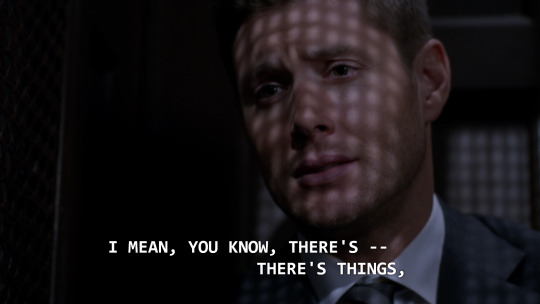
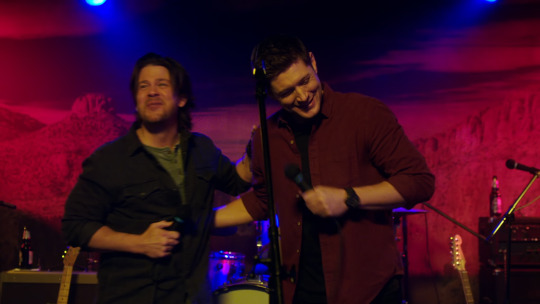
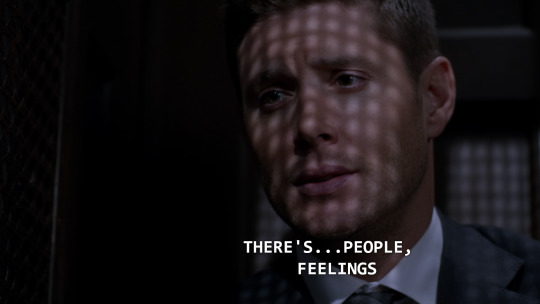

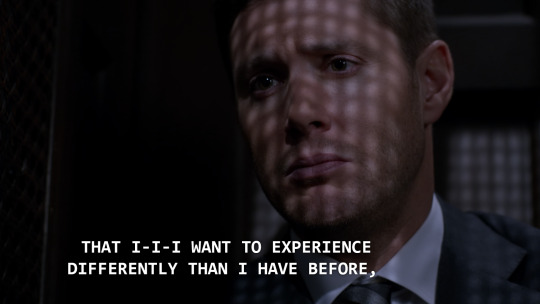



no drug could ever hit like the validation of Supernatural repeatedly telling me I'm right across the years. Everything Means Something™
#oh to be in 2015 when Supernatural was giving me the advanced course in queer cinematic language and it jumpstarted me learning tf to read#this webbed site SO MAD I don't feel taken advantage of by the rebellious queer story this is... because I'm not. it's hilarious#(and everyone who got I included the Pink Flamingos bar on purpose -just like they did- gets a free Golden Gaytime)#supernatural#spn#dean winchester#castiel#destiel#spn meta#spnedit#parallels#dean is bi#spn is queer#10.16#mine#anniversary posting
70 notes
·
View notes
Text
Hello people in my phone!!
So I’m about to start my bachelor’s project at uni and want to write about impoliteness and aggression in online gaming. Do any of y’all know of any streamers/content creators who happen to post about this type of language being targeted at them (or I guess even targeting at others) when they’re gaming online? I want to focus on verbal stuff so in-game chat and such but text based is also fine. It’s also fine if it’s like messages sent in a streamer’s chat. I’m struggling a bit to find more people who make this kind of content (I’ve sent a message to a whopping two content creators lol) so thought I’d ask here in case any of you watch someone who’s often a victim of foul language being used against them. The games I’ve mostly found where it’s an issue is Call of Duty but honestly any online game will do
Also if you have any of your own (uncensored) videos to share with me, please do!!
I should probably also specify that I’ll be looking into this from a linguistic angle (as I am doing a BA in linguistics), so I’m solely looking at the language being used (semantically and pragmatically, perhaps some other linguistic aspects too). Therefore it should be content in English (or Danish if you just so happen to stumble upon that lol)
#more than ok to reblog!!#thanks in advance!#I hope I can find some stuff for this tbh#bc idk what my plan B is yet lmao#also I study linguistics so I’d be researching language from a semantic and pragmatic standpoint#.thoughts#BA project
82 notes
·
View notes
Text
code switching is great because one moment everyone can understand you and the next la frase gets totalmente incompréhensible for tout le mundo except ton cerebro y on ne peut hacer anything about ça
#it's quite an exaggerated example but it makes it even funnier#language learning#langblr#languages#polyglot#studyblr#memes#french#spanish#code switching#my beloved#sorry in advance to those who don't speak french and spanish (←is not sorry at all)
382 notes
·
View notes
Text
"Don't comply in advance!"
We scream to a generation who has had "Le Dollar Bean" burned into their everyday language because they were more ready to preemptively censor and silence queer women than they were to get zero likes of their 30-second internet video.
#“don't comply in advance”#we say to a generation who is so scared of upsetting advertisers and algorithms#that they're teaching their children and little siblings that it's not okay to say the words “rape” or “pedophile”#/ / /#rambles#language#censorship#lesbian#gay#bi#bisexual#trans#transgender#queer#lgbt#lgbtq#queer censorship#tiktok#politics#american politics
25 notes
·
View notes
Text

Basic phrases vs Advanced phrases
#english#language#toefl#youtube#learn english#grammar#education#lesson plan#teacher#teaching#basic english vs advanced english english learning speakenglish native fyp reels reelitfeelit language vocabulary ielts toefl d
34 notes
·
View notes
Text
language learning culture is always watching children’s media in various languages
#benkyou posting#polyglot#langblr#studyblr#language learning#studying#studyinspo#i never watched toooo much childrens shows in japanese but right now my main mandarin study resource is a website made for kids to learn#one of the more advanced stories on the website is a kids version of journey to the west#im so excited to be able to watch that one some day#i do need to start reading (comics) though because im mostly just watching things as immersion in mandarin
493 notes
·
View notes
Note
Omg, is there any more about Odonii battlefield performance?
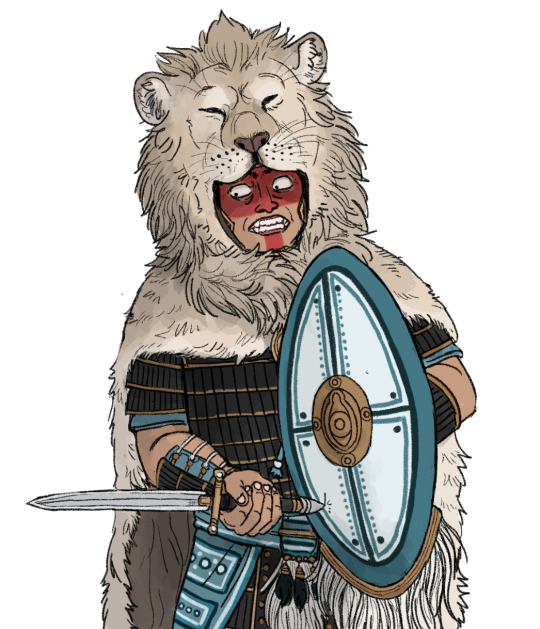
Faiza giving a full battlefield performance, which includes grimacing, sinister looks, letting out terrifying war cries, and banging on her shield with her dagger's pommel. She's wearing a full set of armor, which is functional but highly decorative. A squire will be present somewhere nearby to carry the rest of her weaponry.
As mentioned in the other post, Odonii generally do not actually Participate in fighting. Their perpetual armament and training to correctly Use this armament has predominantly symbolic functions, with their bodies as vessels for state and military empowerment and integrity.
Their normal role on the battlefield is:
a) Spiritual protection for their associated warriors and intimidation of enemies.
Their role is partially to be the ‘guardian lion’ figure in human form, their presence and performance in of itself is considered metaphysically protective. This guardian lion nature is played up and reinforced with their dress and behavior- they wear lion skins over their armor, paint their faces red to obscure human features, perform war cries tailored to sound inhuman (not like lions, just a very shrill and frightening sound). They perform ‘frenzied’ movements that intend to evoke an enraged animal- pacing, banging on their shields, biting their weapons/shields, baring teeth, exaggerated glances that emphasize the whites of their eyes, etc. This can be a disturbing sight- reassuring to their allies who know a frightening spiritual guardian figure is on their side, and demoralizing to an enemy (the latter especially in conjunction with common beliefs that Odonii are witches/shapeshifters)
b) A motivating factor to get the men to fight more bravely.
This is partly out of religious belief (you will probably be a little bolder if you feel reassurance that God is very much present and on your side, via Its priestesses), partly out of esteem for the order (you are highly motivated to perform for their recognition and protect them from harm). In a way, their role on the battlefield is the Least masculinized aspect of their performance- they are in part there to remind men of their mothers, wives, and daughters, who they are supposed to be the protectors of and whose benefit they are ultimately (at least deemed to be) fighting for.
In some cases, this is taken to a (cultural relative) extreme wherein they will expose their breasts towards their own men as a part of battlefield performance, in the form of a supplicatory gesture (bearing the breasts and thumping on the chest with a fist). (The Odomache’s nude body should never be publicly seen under any circumstances, limited and controlled exposure by Odonii Can be appropriate). Breasts are not sexualized in this cultural sphere, but are not treated as neutral body parts either, instead having values of motherly nurturing and feminine vulnerability projected onto them. Odonii showing tits will be a DISTINCT reminder of the ‘vulnerable female’ elements that the men should be protecting, and can be highly motivating (especially in the context of a figure who is otherwise behaviorally ‘masculinized’, it’s jarring and can have useful emotional impact).
c) General spiritual leadership (in connection to a & b).
Weapons dances are an aspect of military training and the kagnoma odo dance is always performed prior to conventional battles, Odonii lead these dances. This has multifacted functions- it is believed to spiritually bless the troops, it is a means of practicing with weaponry/limbering up, it is a psychological rallying point and good for morale, and it may intimidate your enemy who can see it happening from a distance (by displaying readiness/eagerness to battle, good discipline, unity, and physical might). Odonii also perform personalized blessings of soldiers, weapons, and armor.
c) Filling gaps in the command structure or acting as commanders
Odonii are involved in strategic meetings, and ones who receive battlefield roles are very well studied in military tactics. As a matter of technicality, their commands to the body of Imperial Wardi troops do not override those of generals or other ranking soldiers (though they will often be deferred to regardless), but they can fill in gaps in the command structure in case of death of high ranking soldiers or if lines become scattered and communication breaks down.
Additionally, there are two elite warrior orders presided over by the Odonii priesthood (the rest answer directly to the Usoma's court appointed general), with senior Odonii as their commanders and the Odomache as their general. (This is one of many political tension points between the priesthood and monarchy, given that the Odonii have managed to get themselves about 200 high skill, firearm'ed warriors that are separate from the normal military structure, only as loyal to the Usoma as their current general is, and Very beloved among the public so you can't just like, outright kill or disarm this very obvious threat.)
d) A strategic flexing of eastern seaway honorable combat norms
Conventions of honorable warfare have broad commonalities across the eastern seaway peoples, one of which is that noncombatants (by default- women, girls, prepubsecent boys, unarmed elderly men) are not legitimate targets in the normal process of open war (but are fair game in contexts like sieges when a foe has refused to surrender on behalf of their population). Odonii being armed throws a wrinkle into this - they are still effectively ‘noncombatants’ by virtue of being women, but if they actually Engage in fighting they do present a threat that could be justifiably neutralized.
If they do not actually Use their arms they are not legitimate targets, and an enemy concerned with honorable combat will have to work around their presence (or risk social/retaliatory consequences if he does not). They are thus effectively human shields- at the very least introducing an additional layer of difficulties for an opponent to navigate, and sometimes actively putting their bodies between their men and their opponents.
e) as a factor of D, potential mediator figures.
When in conventional battles, Odonii on losing sides are usually expected to allow themselves to be captured without resistance. They stand a very high chance of being taken alive and remaining unharmed due to a combination of factors- baseline honorable warfare practices (which are ABSOLUTELY not always followed, but at least Influence behavior), fears of material consequences in retribution for harming the priestess, fears of spiritual consequences for harming a potentially powerful witch, knowledge that releasing an Odonii unscathed may give the captors a better negotiating position down the line, or knowledge that an Odonii is a very valuable hostage and can make for a good bargaining chip.
Because of this element, captured Odonii are expected to perform mediation roles, negotiate the release of hostages, carry messages from their captors, or bravely tolerate hostage conditions (ideally while gaining intelligence on their captors)
---
Odonii very, very rarely actually participate in combat (and are in fact not Supposed To in the vast majority of circumstances).
They are, however, fairly well equipped for it. Their perpetual armament is symbolic in nature, but its intended function of empowering their bodies and the state by proxy additionally requires them to know how to Use It. They are trained and regularly drill and engage in mock battles in each of their key weapons/defensive combinations (sword, sword and shield, spear, spear and shield, longgun, handgun) and are expected to be adept at their use. Odonii who attend battlefields, while not being directly engaged, are still in very high-stress and dangerous environments and will have to learn to stay calm and collected under duress. All this doesn't mean every Odonii would be a skilled warrior in an actual combat situation (given that most will have no experience fighting someone who is actually trying to Kill Them), but it does mean they have enough technical skill and mental fortitude to stand a decent chance.
The only times where they are SUPPOSED to actively engage is when a battle is deemed as an existential struggle and is being lost (in practice, the main context for this is a siege), or losing against a foe deemed so thoroughly depraved that they won’t even slightly follow wartime conventions. The idea in these situations is that they are most likely already doomed, and that they should die protecting their people in battle.
Wardi history is filled with stories of Odonii fighting and dying in desperate conflicts (particularly against Imperial Bur), but this is at least Partly historical revisionism (there WERE some women in proto-Odonii roles involved in these conflicts, but these retellings project the modern Odonii order onto its multiple progenitor practices).
Odonii are frequently present on battlefields, but there are only two major instances of modern era Odonii participating in battle as full combatants, both involving conflict with Finnerich
---
The fully modern incarnation of the order can be defined as starting in the late period of Burri occupation, in which multiple Wardi city-states and kingdoms allied against a common foe, and the separate progenitors of the Odonii tradition began to coelesce into a single practice. These alliances were mostly dropped after Burri withdrawal, and the immediate post-withdrawal period was a chaotic scrambling to politically stabilize and assert old territorial claims- thus most Wardi states resumed hostile or indifferent relations with one another. (The one exception is that Wardin and Ephennos remained allied, which shortly would become a Big Deal). Forms of early Odonii now existed throughout most of these states, just not united under a single banner.
The city of Godsmouth was blockaded and besieged by Finnerich during this period (taking advantage of its historical rival’s weakness in the political chaos of de-occupation and hoping to capture or at least maim the city), and some of these early Odonii were involved in this conflict and are known to have engaged.
Godsmouth was a rival to its neighboring states more than anything else- there was little reason for others to send aid in the conflict, and it was left to fend for itself. It was and is a heavily fortified city, and thus the siege lasted for months, with the strategy turning to starving the population out rather than the risky maneuver of throwing troops at well-defended gates to force entry. The Finn forces never managed to breach the inner walls, but were very successful at starving the city's population, raiding its farmlands and villages, and destroying its ports and capturing or burning its ships, all with minimal casualties on their side.
The strategy of the siege finally turned to a risky push to breach and capture the city (due to Finnerich’s own dwindling resources and logistical difficulties in restocking due to storms at sea, and news that an allied Wardin and Ephennos had, in an unprecedented move, been persuaded to send reinforcements (in return for Godsmouth's sworn fealty and absorption into their alliance)), and Finn forces succeeded in breaking through the outer walls. This developed into a very dramatic standoff in which the remaining warriors and/or civilians of Godsmouth attempted to fend off the attack long enough for reinforcements to arrive (which would take days by sea).
Odonii are very famously known to have fully engaged in this stretch of the conflict on the front lines, as it represented an existential threat to the city-state (it’s a fortified settlement, if it was captured, reinforcements would not matter). Some of the recountings are distinctly fanciful (describing Odonii and noblemen leading Siege Of Helms Deep style khaitback charges into masses of enemies, or SWEARING that one of them actually did turn into a lion and ripped apart a hundred Finns before she succumbed to her wounds). An At Least Partially True Story With Exaggerated Elements of the final days of the siege describes the Odonii priestess Hibrides Odiboe rallying a group of elderly men into battle by baring her breasts and scratching deep, bleeding wounds into her chest, declaring herself as 'your mothers, your wives, your daughters, and look how I bleed while you hide behind your walls and wait to die.' While accounts have fantastical elements, it is factual that Odonii priestesses fought and died defending the city's inner walls, notably filling command positions left vacant by slain or starved leaders and rallying citizens to the front lines.
The end of the siege was ultimately a pyrrhic victory for Godsmouth- the city was never actually taken but its population was starved and riddled with disease, its farmlands were burned, and its ports were destroyed. Finnerich forces retreated before reinforcements arrived after failing to break through the inner walls in time, but had succeeded in most objectives of severely wounding their historical enemy. It has been a source of collective trauma in Godsmouth since that point (it is now out of living memory, but vivid stories remain of seeing the dead eaten by dogs and the starving eating the dogs that ate the dead, watching family members succumb to disease and starvation, all while hearing the sounds of fighting draw closer and closer with no reason to believe that any help would ever come), but ultimately recontextualized as a victory, a turning point in the arc of modern history. (The Wardin-Ephennos-Godsmouth alliance, which formed in full as a result of this conflict, would become the triple state that conquered the rest of the region and formed Imperial Wardin).
The direct participation of Odonii in this conflict is heavily played up in the narrative as the order in its purest form as sovereignty incarnate, the priestesses bravely fighting for (what would turn out to be) the beginnings of the Imperial Wardi state. The 11 Odonii who died fighting in the siege have been bestowed sainthood and are memorialized in a series of guardian lion statue-shrines overlooking Godsmouth’s ports (in which their ashes and bones are stored).
---
The other instance of modern era Odonii engaging in conflict is significantly less romantic, occurring in the context of the Extremely failed second invasion of Finnerich.
During and after the rout that resulted in the Odomache's capture and killing, it became exceptionally clear to the Imperial Wardi forces that They Were Fucked. The conflict veered with REMARKABLE speed from being an attempt end the state's civil war between the Imperial Wardi-loyalist provincial puppet government and its rebelling northwest population, to a desperate struggle for Wardi forces to get out of Finnerich Alive. At this point it was assumed (fairly accurately) that any defeated party would be summarily executed, so most Odonii present ended up directly engaging in battle. Two are known to have died leading soldiers in a bid to retrieve the Odomache's body, others fought and/or died while defending the retreat.
A few Finn Odonii (women appointed as a local sect of the priesthood after the initial takeover) remained in the capital after the Wardi forces fucked off overseas, and were executed along with the rest of the installed loyalist government and priests (though it's unlikely that they were involved in any fighting, as the provincial government surrendered after the withdrawal).
Odonii veterans of the invading force have not fared well in the aftermath. Most of those who survived the ambush in which the Odomache was captured have ended up committing honorable suicide due to breaking vows in abandoning their leader in retreat, failing to retrieve her body, and/or being assaulted in capture. More have committed (ostensibly ritual, probably emotionally driven) suicide in the years that followed, with the knowledge that their leader's death and defilement and this severing of God's spirit has brought doom upon their land in the form of an unbroken drought and famine, and that they failed to prevent this. The priestess who was captured alive to witness the Odomache's death and released unharmed to report it was the first.
All this has opened some vacancies in the order's leadership, and given things a very somber tone. It is currently in debate as to whether the ones who died on Finn soil (particularly those who died attempting to retrieve their leader's body) should be canonized as saints or if it's a little too soon for all that.
#As usual this veered off but likeeeeeeeeeeeeeeeee whatever. It's technically all Sort Of about Odonii battlefield performance.#Just like. Imagining if Imperial Wardin was an actual historical state whose written language was never decoded. There would be SOOOOOOOOOO#much debating on whether they actually had 'warrior women' or not. So much.#And it would probably end up wildly mischaracterized in pop history circles who base their estimates of a historical culture's#level of gender egalitarianism almost entirely upon Can Girl Fight??????? Did Girl Fight In Epic Battles Though?????????? With Sord????#Almost completely unrelated but I'm downgrading the gun tech. Kind of severely. I'm okay with a little anachronism because it doesn't#follow an earth timeline but it's Too anachronistic for the rest of the setting.#Like I need the use of firearms to be VERY limited and not widespread so they need to be in basal stages. The main reason I originally#had much more advanced firearms was due to old lore that is now obsolete anyway.#They're gonna be a lot closer to hand cannons. Like a transitional form of hand cannon closer in shape to a conventional#rifle but without a mechanical firing method.#This means a lot of things I've drawn recently are now obsolete and the joke of Couya having terrible trigger discipline doesn't work#but it has been bothering me way too much I can't do it anymore
116 notes
·
View notes
Note
today we did our german essays (german is literally my fourth language, so no skills detected) and we were supposed to write "an email to our international friend" so i adressed it to you, lol. peak parasocial
I LOVE THAT and hey i'm sure your german is better than mine at least if that helps lmao. in hindsight i should've done german at school but i wanted to avoid that class because it's where everyone who wanted to just fuck around went because german is far easier to learn as a norwegian person than fucking spanish or french. i ended up having to do french and you can imagine how well that went
#hit my first depression era and dropped out of french to do advanced english instead#advanced being a very generous term it was the easiest class i've taken in my life#easier than regular english even just because our teacher actually knew the language#yes i was the asshole correcting my teacher every standard english lesson i'm sorry#she appreciated it though she started just asking me straight up#other languages though.... not too good at them i fear.....#answered
26 notes
·
View notes
Text
in some ways its funny when i hear people saying THE ANIMATION INDUSTRY IS COLLAPSING!!!! the AMERICAN animation industry is collapsing. australia is doing better than it ever has before
#sneefs text#i dont want the american industry to collapse btw. obviously. i feel great empathy for the artists over there getting fucked and i want to#continue seeing great movies from a country that has madeva lot of great movies#but i also want people to stop acting like animation will die without america. there are so many advances being achieved elsewhere#if yr so concerbed about whatchkng good quality animated movies you can start supporting foreign films#you can watch animated movies in other languages. you can read the subtitles. i believe in you
21 notes
·
View notes
Text
Since Shiny has worked as a waitress for years, in her teens, and in the burlesque club before she got to officially join the dancers, she knows diner lingo like the back of her hand. The first time she treated the boys out to dinner, Psycho and Stupid (and probably Greasy) looked at her like she just performed witchcraft.
#Yes this is an excuse to say that if she had heard Bubble Bass' order she would have throttled him#because a sandwich like THAT needs to be prepped and ordered in advance#not ordered on the spot-#call Shiny a polyglot- she knows Spanish scatterings of various languages and diner#*and French when she befriends Poppy#XD#oc tid-bits#Shiny Weasel#my own oc's#wfrr#tooniverse#toon patrol#who framed roger rabbit
12 notes
·
View notes
Text
Learning a language is so wack, because now when I manage to read something in Spanish I didn't understand around 5 months ago I just go

21 notes
·
View notes
Text
vocabulaire de lecture: Trois oboles pour Charon (chapitre 1, 1ère partie)
obole: aumône = offering/pittance
(corps) lardés: transperçés = pierced/stabbed bodies
remugles (de sang): relents = strong smell persisting
un trépassé pansu: un cadavre qui a un gros ventre = a deceased person with a big belly
acanthes: plante de Méditerranée = acanthus (mediterranean plant)
sépulture: caveau/tombeau = grave/tomb
frondaisons: feuillage = foliage
une combe: vallée = valley
branches charriées par l'onde: branches emportées par l'eau = branches carried by the water
talus: terrain en pente = embankment
touaille: linge/tissu à plusieurs usages au Moyen-Age = cloth/towel/linen roll
s'étioler: décliner/se dégrader/perdre de la force = to wither/fading away
hampe: manche = handle/shaft
frimas: brouillard givrant = freezing fog
calcinés: brûlés = bruned
appentis: dépendance/abris = shed
madriers: poutres = beams/timber
jonché: parsemé/recouvert = covered/littered with
tesson: débris = shard
barbon: homme âgé = old man
patibulaire: inquiétant = suspicious-looking
brouet: potage = broth
frusques: vieux habits = old clothes
#vocabulaire français#vocabulaire#french words#french vocabulary#Trois oboles pour Charon#french language#french#french langblr#french learning#studyblr#Advanced vocabulary
31 notes
·
View notes